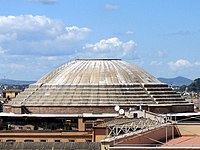
Photo from wikipedia
Eco-cements are a desirable alternative to ordinary Portland cements because of their lower CO2 footprints. Some ye’elimite-based eco-cements are attracting a lot of interest. Understanding the reasons for the mechanical… Click to show full abstract
Eco-cements are a desirable alternative to ordinary Portland cements because of their lower CO2 footprints. Some ye’elimite-based eco-cements are attracting a lot of interest. Understanding the reasons for the mechanical performances requires the characterization of features such as mass density of the hydrated component phases, including the amorphous gel, on the submicrometer scale, which is challenging. Here we use ptychographic X-ray computed tomography to provide 3D mass density and attenuation coefficient distributions of eco-cement pastes with an isotropic resolution close to 100 nm allowing to distinguish between component phases with very similar contrast. In combination with laboratory techniques such as the Rietveld method, 27Al MAS NMR, and electron microscopies, we report compositions and densities of key components. The ettringite and gel volume distributions have been mapped out in the segmented tomograms. Moreover, we discriminate between an aluminum hydroxide gel and calcium aluminum mono...
Journal Title: Journal of Physical Chemistry C
Year Published: 2017
Link to full text (if available)
Share on Social Media: Sign Up to like & get
recommendations!